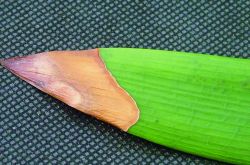Plant
Doctor Archive
Callas
and Clivias
  I
HAVE two problems, the first with arum lilies planted near the fish
pond. They get brown splotches on the leaves while the same varieties
in other parts of the garden are not affected. Also, can you tell
me what causes tip browning on clivias as the leaf gets older? I
HAVE two problems, the first with arum lilies planted near the fish
pond. They get brown splotches on the leaves while the same varieties
in other parts of the garden are not affected. Also, can you tell
me what causes tip browning on clivias as the leaf gets older?
 THE
leaf sample you sent looks more like a calla (Zantedeschia)
than a true arum, but name changes take a long time to become widely
used and lots of gardeners still refer to them all as arums. THE
leaf sample you sent looks more like a calla (Zantedeschia)
than a true arum, but name changes take a long time to become widely
used and lots of gardeners still refer to them all as arums.
In damp soil, callas
are rather susceptible to a bacterial disease called Erwinia
that causes rot in the tubers as well as brown patches on the foliage
and sometimes the flowers. The soil near your fish pond may not
drain as well as the rest of the garden, hence the problem being
confined to that area. Unfortunately, it is a difficult disease
to get rid of, so probably the best thing to do is dig up and destroy
the affected tubers and only grow callas in well-drained parts of
the garden.
Dieback of clivia leaves
is an interesting question. With most other plants, leaf tip dieback
is usually the result of salt accumulations through over fertilising,
or drought or poor drainage or some other problem affecting the
root system. But with clivias, no immediate answer springs to mind,
so I checked with clivia breeder Dr Keith Hammett who says that
although some experimental work has been done to try to determine
the cause of clivia leaf dieback there have been no clear results
as yet. Keith has seen leaf dieback on clivias in the wild and says
severely affected plants may collapse almost completely, but they
usually recover some time later. To keep clivias looking their best
he suggests you remove the affected leaves or trim off the brown
portions carefully with sharp scissors. But rather than slicing
straight across the leaf, cut them into the same shape as nearby
leaves to maintain a natural look.
Weekend
Gardener, Issue 201, 2006, Page 31
Reproduced with permission from the former Weekend Gardener magazine. The views expressed here are not necessarily those of the RNZIH.
|
 |
 |
|